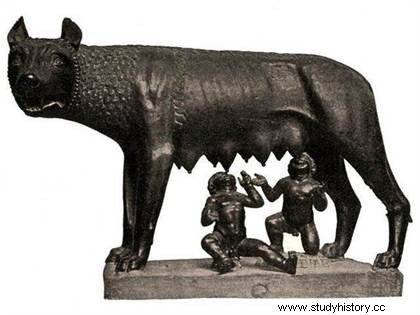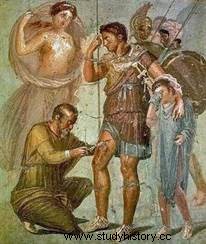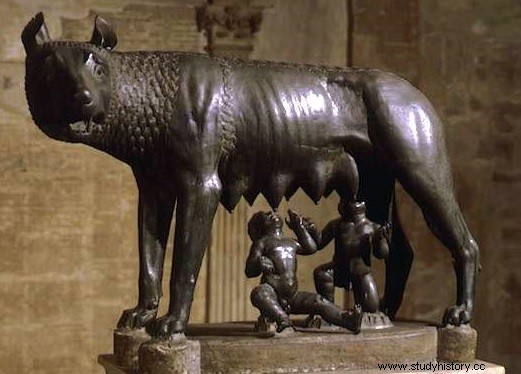 According to tradition, Rome was founded by Romulus and Remus on the Palatine Hill in 753 BC. J.-C. Romulus is the first king of this city resulting from the gathering of Latin, Sabine and Etruscan tribes around common laws. Romulus and Remus are referred to as the sons of Mars, god of war, and a priestess of Vesta. Thrown at birth into the waters of the Tiber and taken in by a she-wolf, the twin brothers decide to found a city where the river has thrown them back onto dry land. The most famous representation of this myth is an Etruscan statue dating from the 5th century BC, called the Capitoline Wolf.
According to tradition, Rome was founded by Romulus and Remus on the Palatine Hill in 753 BC. J.-C. Romulus is the first king of this city resulting from the gathering of Latin, Sabine and Etruscan tribes around common laws. Romulus and Remus are referred to as the sons of Mars, god of war, and a priestess of Vesta. Thrown at birth into the waters of the Tiber and taken in by a she-wolf, the twin brothers decide to found a city where the river has thrown them back onto dry land. The most famous representation of this myth is an Etruscan statue dating from the 5th century BC, called the Capitoline Wolf.
The legendary foundation of Rome
Rome , the mere mention of this name is enough to create in the imagination of many people an incalculable number of images both related to the City itself, the Urbs , than with his men, his armies, his masterpieces. Rome is however above all a city-state, a very old model born in Greece which makes the association of an urban core and a territory a whole, an indivisible entity, which with Rome will coincide with the entire Mediterranean basin. Rome was, as we know, the center of an immense Empire, it subjected the most diverse countries to its authority, most of the time by iron, thanks to the power of its legions...
But Rome itself has an origin, a birth, whose agreements come to us through mythology as it is so ancient. This too ancient past escapes for the people of Antiquity to historical rigor and has its roots in the time when heroes and gods walked on earth and lived alongside men.
Aeneas and his descendants
 Indeed, during the famous Trojan War, Aeneas, a hero, left his city in flames with his father Anchises and his son Ascanius, and eventually ended up in Italy, in what soon became Latium, and met the Aborigines of Latinus. Trojans and Aborigines would be, according to two traditions, either confronted and the first, winners, would have received the submission of the king, or, even before the battle Latinus would have linked up with Aeneas, recognizing his merits.
Indeed, during the famous Trojan War, Aeneas, a hero, left his city in flames with his father Anchises and his son Ascanius, and eventually ended up in Italy, in what soon became Latium, and met the Aborigines of Latinus. Trojans and Aborigines would be, according to two traditions, either confronted and the first, winners, would have received the submission of the king, or, even before the battle Latinus would have linked up with Aeneas, recognizing his merits.
Thus united, the two peoples would have supported the war against the Rutuli and then the Etruscans, whom they defeated. Aeneas founded the city of Lavinium in homage to his wife. After his death, his son took power, but he left the city to his mother (or mother-in-law according to tradition; Aeneas having had a son with his first wife Créüse, also named Ascagne, but also Jules), because too populated and went to the Albin Mountains to found another city, Albe-la-Longue.
There then followed a whole series of kings from father to son until Numitor, the eldest, and his brother, Amulius. The second ousted his brother, killed his sons and, under the pretext of honoring him, chose his niece, Rhea Silvia as a vestal (a priestess) in order to guarantee her virginity. But, Livy insists on the destiny of a Rome according to him called to dominate the world, and according to tradition, speaks of the relationship between Rhea Silvia and the god Mars, from whom were born two twins, Romulus and Remus.
But the king, made aware of this double birth, had Rhea put in irons and asked to throw the children into the Tiber. Swelled by the waters, the calm river left the cradle on the bank. A thirsty wolf then appeared, heard the cries of the two brothers and fed them, while a shepherd, Faustulus discovered them and took them to his sheepfold where they were raised by his wife Laurentia, who according to another tradition mentioned by Titus Live, would have been a prostitute, a wolf (lupa for it is the same term in Latin; see lupanar in French) which would be the origin of the wonderful legend.
The childhood of the twins Romulus and Remus
The children, raised in the sheepfold, grew up and became passionate about hunting, then not content to oppose wild animals, they confronted the brigands of the region. They shared their booty with the shepherds and then built up a troop of young people to continue to fight against the brigands. The latter then ended up ambushing the young people and Remus was captured and delivered to King Amulius, the very one who wanted them destroyed.
The grievance against him was the violation of the property of Numitor, the brother ousted from power. So Remus was handed over to him and he held him captive. Faustulus, their adoptive father, who foresaw their royal ancestry from the start, then revealed his secret to Romulus. At the same time, Numitor who had learned that Remus had a twin, made the connection with the children of Réha Silvia and ended up recognizing his grandson.
 Thus two plots were hatched against Amulius. Romulus rounded up the shepherds and told them to gather quietly in the royal palace in order to free Remus. But this one at the same time converged on the palace at the head of another troop. Faced with the spontaneity of the revolt, Amulius is killed. Numitor who gathered the people, then presented him with the whole story, how his brother had robbed him of his power and had wanted to assassinate his grandsons.
Thus two plots were hatched against Amulius. Romulus rounded up the shepherds and told them to gather quietly in the royal palace in order to free Remus. But this one at the same time converged on the palace at the head of another troop. Faced with the spontaneity of the revolt, Amulius is killed. Numitor who gathered the people, then presented him with the whole story, how his brother had robbed him of his power and had wanted to assassinate his grandsons.
It was then that the twins arrived at the assembly and hailed their grandfather as king, which the crowd hastened to do in turn. It was then, after returning royal power over Albe-la-Longue to their grandfather, that the two brothers decided to found their own city.
Romulus defeats Remus and founds Rome
To decide between them and to know which one would have the honor of being the founder of the new city, Romulus and Remus decided to rely on the gods. They went to the place where they had been abandoned on the river and each went up a hill; Romulus chooses the Palatine and Remus the Aventine. Remus was the first to receive an omen; six vultures, birds symbolizing Jupiter, presented themselves to him. But immediately after, Romulus received double and each was proclaimed king by his group, Remus because he had had his omen first, Romulus by virtue of the higher number.
The conflict would then have degenerated into a struggle where Remus would have fallen dead. Another tradition, evoked by Titus Live, tells that Romulus, in the process of building his city, would have shot down his brother, who, to make fun of him, would have jumped over the new walls. Romulus would then have declaimed:"Thus perish in the future whoever crosses my walls". The city then took the name of its founder. The tradition, fixed by Varro, estimates the date of 753 BC. J.-C. for the foundation of Rome.
In order to populate his city, Romulus welcomes escaped slaves and outlaws. Then, to give them companions, he organizes a party during which the wives of their hosts, the Sabines, are kidnapped – this is the famous kidnapping of the Sabines, which has been the subject of numerous artistic representations. After several wars between Romans and Sabines, a reconciliation takes place, and Romulus becomes the king of the two unified peoples. During his long reign, he endowed the city with several political institutions, then mysteriously disappeared during a storm. Romulus is later equated with Quirinus, god of war of the Sabines.
Representation of myth in the arts
The childhood of Romulus and Remus, suckled by the wolf and then taken in by Faustulus, has been the subject of many artistic representations. These include the famous Capitoline Wolf (mid-5th century BC, Palace of the Conservators, Rome), an Etruscan bronze depicting twins suckling the animal, and the canvas Romulus and Remus collected by Faustulus from Pierre de Cortona (1643, Louvre Museum, Paris). Annibale Carracci is the author of a History of Romulus (1588-1592, Magnani Palace, Bologna).
To go further
- Roman History, Volume I:The Foundation of Rome, by Livy.
- Romulus, twin and king:Realities of a legend, by Dominique Briquel. The Beautiful Letters, 2018.
